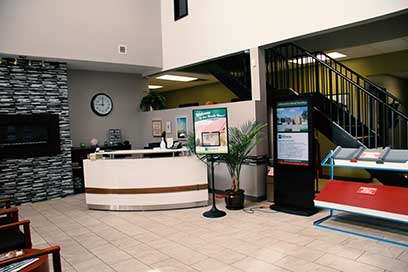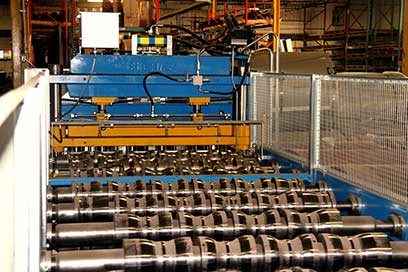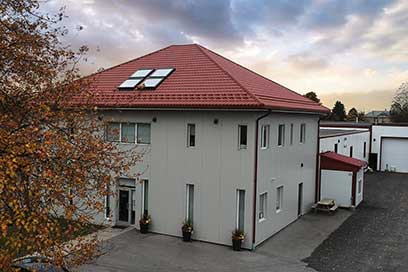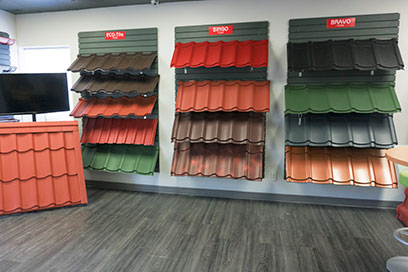
View metal roofing terminology here »
We are one of only three companies that have a warranty with the paint manufacturer - Beckers.
Beckers provide London Eco-Metal Manufacturer the BeckryTech material produced by ArcelorMittal in Canada under the trade mark Granite Deep Mat.
Steel materials have an automatic guarantee provided by the manufacturer. (G90 or 275 g/m2). The guarantee applies automatically from the moment the product is delivered to the client, so there is no paper guarantee issued to the client.
The Automatic guarantee is not conditional upon mandatory annual maintenance inspections.
For roofing applications, the slope of the roof has to be a minimum of 3/12 and the guarantee is not dependent on roof orientation.
Freedom of part design is covered by the guarantee.
| Property | ASTM Method | Granite Deep Mat | |
|---|---|---|---|
| Film Thickness | D5796, D1005, D4138 | Mil | 1.0 +/- 0.2 |
| Formability/Adhesion (T-Bend test) | D4145 | 2T no taped removal | |
| Gloss (60 degree) | D523 | GU | <6 |
| Film integrity | 40 years | ||
| Colour Change | D2244 | Vert. | 30 years – dE 5 max |
| Non-Vert. | 30 years – dE 8 max | ||
| Chalking | D4214 (Method A) | Vert. | 30 years – 8 min |
| Non-Vert. | 30 years – 6 min | ||
| Geographical Limits | Canada and Continental U.S. | ||
| Application Guide | Granite Deep Mat | ||
| General market application | Product application |
Residential
and commercial buildings, roof panels (tile profiles) |
|
| Climates, country, regional localisation | Weathering requirement |
Typical
UV and temperature conditions in North America. |
|
| Environments, air pollution, chemicals resistance | Corrosion requirement |
Normal environments (rural, urban and light industrial) |
Terminology used to describe roof types and components might be a foreign language for those who are not familiar with it. While it is appreciated that certain words have other meanings we have listed below an explanation of words used when discussing the structure or type of roof.
Cross Gable: to a gable roof (see below), but has two gable parts that cross in a “T” like fashion.
Cross Hipped: Similar to a hipped roof (see below) but this type has two parts that cross.
Flat: A flat roof has no slope at all.
Gable (see cross gable above): A simple triangular shaped roof from the side with two rectangle sections opposing each other creating an upside down “V”.
Gambrel: This roof looks more traditionally barn or bell shaped than triangular when viewed from the side. It is like a flattened gable roof. Many farms have gambrel roofs.
Hipped (see cross hipped above): A pyramid shaped roof where four triangle sections are sloped to meet in a single point.
Pavilion Hipped: A simple triangular shaped roof from the side with two opposing isosceles trapezoids that meet at the hip of the roof thus creating two angled sloped triangles sections. This roof type is typically a low-pitched roof.
Mansard: This roof type has a lower sloped area at the top with four heavily sloped sides slanting out to meet and/or exceed the walls of the building.
Shed: A single sloped roof.
Saltbox: Similar to a gable roof, but the two sides are not symmetrical.
Metal Roofing: Unfortunately, in the past, metal roofs were not designed with esthetics in mind. Let’s be honest, we have all seen those old, boring and unimpressive tin roofs on farm buildings. But in fact, these roofs were very durable. Farmers put them on their farm buildings strictly for practicality as metal roofs are designed to be a long-term and no-maintenance solution. Many historic and artistic buildings were capped with aluminum over 100 years ago.
No longer an ugly duckling, metal roofing comes in a rainbow of different colours, a multitude of exotic finishes and elegant profiles. Our superior quality coatings provide energy efficient solutions for today’s homeowners. Additional benefits of metal roofing not offered by asphalt shingles include, but are not limited to absence of mold, mildew, cracking, rotting, chipping, and curling. Its fire resistant properties and the ability of snow to slide off of the roof, represent additional safety characteristics of the metal roof.
Metal pricing goes from steel on the low-end to aluminum (mid) and to copper (high end). Aluminum is considered to be the “miracle” metal. It is extremely light and for years it has been used to build airplanes. Worldwide demand for aluminum has caused its price to rise in recent years. Nevertheless, it is an ideal building material in many industries. Like steel, it is available in a variety of colours and profiles. Before you dismiss metal roofing as too expensive, contact London Eco-Metal Manufacturing Inc. for a quote, because metal roofing represents your best step up the performance ladder.
Beam: A long piece of wood or steel supporting your roof and when grouped, can form a truss.
Coverage: The degree of weather protection offered by a roofing material: single, double or triple coverage.
Decking/Sheathing: Normally plywood which provides a flat surface covering your home.
Dormer: A gabled extension protruding from a sloping roof, usually to allow for a framed window.
Drainage: Shape, layout and slope of roof for the purpose of shedding water, ice, and snow.
Drip Edge: Weather-resistant metal or vinyl edge installed along eaves and rakes to facilitate shedding of water at the edges.
Eaves: Parts of a roof that project beyond or overhang the face of the wall.
Eavestrough: Also known as gutters. They provide a method by which water dripping off the roof is caught and carried to the downspouts and then carried away to an appropriate area.
Exposure: Specifically, exposure to weather. Also the distance from the butt edge of one shingle to another.
Fascia: The vertical edge of the roof, either behind the eavestrough or at the edge of a gable.
Felt: A breathable type of building paper made of a strong, tough base saturated with asphalt.
Flashing: Material used to prevent leaking/seepage at certain vulnerable spots like valleys, top or end-walls and chimneys.
Gable: The end wall of a building which comes to a triangular point (upside down “V”) under a sloping roof; also a type of roof.
Hip: An external angle formed by the meeting of two sloping ends of a roof, from the ridge to the eaves; also a type of roof.
Rafters/Trusses: A framework of beams, usually grouped in a triangular nature supporting the roof.
Rake: The inclined edge of a pitched roof.
Ridge: The apex of the angle formed by a roof, or the peak, where the common rafters meet.
Roof Covering: Most common are asphalt shingles, wood shakes, metal, clay tile, slate or copper.
Sofit: The horizontal bottom of the roof overhang.
Square: The amount of roofing material required to cover 100 square feet (10'x10') of roof surface.
Underlayment: A layer of moisture protective material between the decking and exterior roof covering. In northern climates an ice and water shield helps to minimize ice damage problems.
Valley: An internal angle or water runway formed by the intersection of two slopes on a roof.
Venting: Proper venting is necessary for maintaining air-flow and overall roof “health.”





No, thanks to Newsletter. Just get me directly to the Promo Entry Form